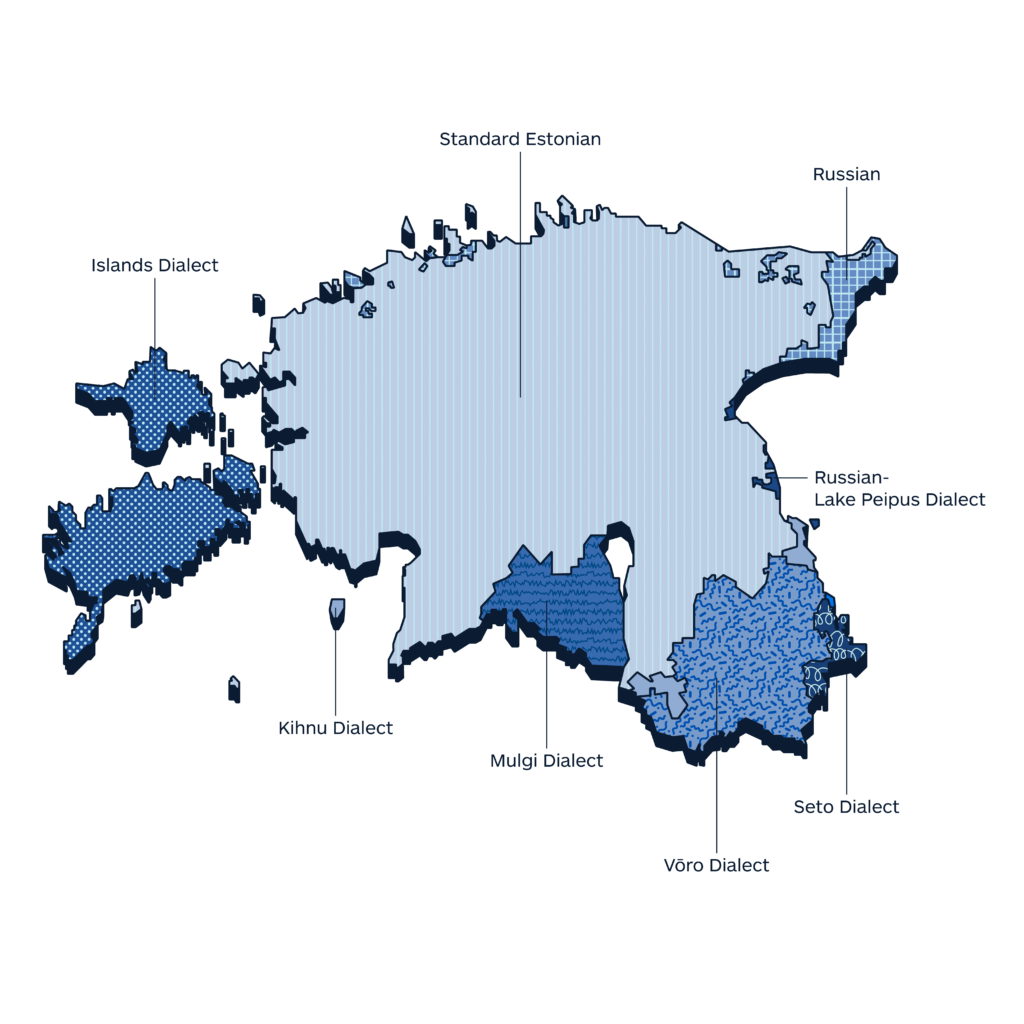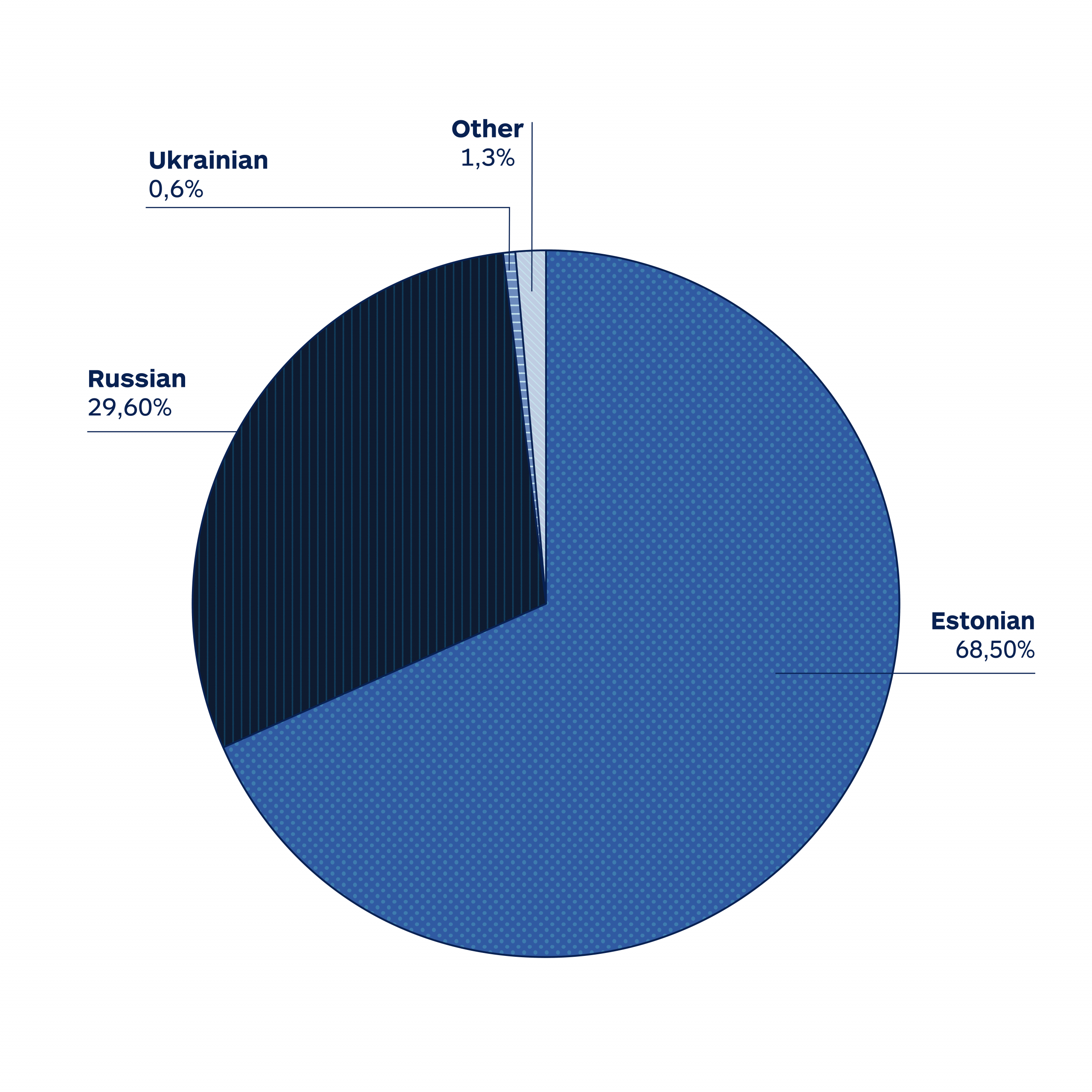Europe
To which language should you translate to localize in Estonia?
What we know from our community
In the last two decades, Estonia has shot to fame as one of the most digital countries in the world. Although grandmas are still pickling tomatoes in the traditional way and two-thirds of the Estonian population lives outside of the capital, modern courier robots have taken to the streets to deliver goods and (e-)residents sign legally binding documents on their phones while hanging in hammocks in remote fishing villages. As a country with low population intensity, 50% forest coverage and the highest number of start-ups per capita in Europe (including unicorns), Estonia relies on the digital systems put in place to allow people to work, vote and run businesses remotely. In fact, Estonia enjoys digital signatures and paperless communication with 99% of its government services. Everything is available from the comfort of one’s home and lots of Estonians even compete in filing their tax returns the fastest.
EstonianMarion, English/Estonian translator
Eesti on viimase kahe aastakümne jooksul kogunud kuulsust kui üks digitaalsemaid riike maailmas. Kuigi siinsed vanaemad marineerivad tomateid endiselt traditsioonilisel moel ja kaks kolmandikku riigi elanikkonnast elab väljaspool pealinna, on linnatänavatel vaikselt suhisemas kaupu tarnivad kullerrobotid ning (e-)residendid allkirjastavad juriidiliselt siduvaid dokumente kaugetes rannakülades võrkkiikedes lebades. See on Skandinaavia ideaal: olla võimalusel üksi ja samal ajal teistega koos. Eesti on madala asustustiheduse riik, mis on 50% ulatuses kaetud metsaga ning kus paikneb Euroopa suurim arv idufirmasid (sh ükssarvikuid); riik, mis tugineb digisüsteemidele, mis võimaldavad inimestel kaugvormis töötada, hääletada ja ettevõtteid juhtida. Eestis toimub 99% suhtlusest riigiasutustega paberivabalt ja digiallkirjade toel. Teenused on mugavalt kodust kättesaadavad ja eestlased võistlevad vahel isegi selles, kes oma tuludeklaratsiooni esitamises kõige kiirem on.
LANGUAGE INSIGHT
Official language
Estonian (68.5%)
Actual languages
Estonian (68.5%), Russian (27.6%), Belarusian (1.4%), Finnish (0.7%), Ukrainian (0.6%), other (1.2%)
What the top 150 best localized websites in the world do in Estonia
(Top 150 websites listed in the Global by Design ranking – published annually by Byte Level Research, this report provides a list of globally localized websites, showcasing best practices and emerging trends in their globalization)
- 56/150 localize by translating into Estonian
- 4/150 localize by translating into both Estonian and Russian
- 2/150 localize by translating into Russian
- 1/150 localizes by translating into both Estonian and Estonian Sign Language
- 1/150 localizes by translating into both Estonian, Latvian and Lithuanian
- 1/150 localizes by translating into Russian, Spanish, French, German, Italian, Portuguese, Simplified Chinese, Traditional Chinese, Japanese and Korean
- 1/150 localizes by translating into both French and German
- 1/150 localizes by translating into Russian, Spanish, French, German, Italian, Portuguese, Simplified Chinese, Traditional Chinese, Japanese, Romanian, Polish, Turkish, Thai, Ukrainian, Hungarian and Bahasa Indonesia
-
3M
-
ABB
-
Accenture
-
Adidas
-
Adobe
-
Airbnb
-
Aldi
-
Amazon
-
American Airlines
-
American Express
-
Apple
-
Audi
-
Autodesk
-
Avis
-
Bayer
-
BMW
-
Booking.com
-
Bosch
-
British Airways
-
Bumble
-
Burberry
-
BYD
-
Canon
-
Capgemini
-
Cartier
-
Caterpillar
-
Chevrolet
-
Cisco Systems
-
Citibank
-
Coca-Cola
-
Costco
-
Dell
-
Deloitte
-
Delta
-
DHL
-
Disney+
-
Dyson
-
eBay
-
Eli Lilly
-
Emirates
-
Ernst & Young
-
Facebook
-
FedEx
-
Ford
-
Four Seasons
-
Fujifilm
-
GE
-
Gillette
-
GoDaddy
-
Google
-
Gucci
-
Haier
-
Heineken
-
Hermès
-
Hertz
-
Hilton
-
Hisense
-
Hitachi
-
Honda
-
Hotels.com
-
HP
-
HP Enterprise
-
HSBC
-
Huawei
-
Hyatt
-
Hyundai
-
IBM
-
IKEA
-
Intel
-
InterContinental Hotels
-
J&J
-
Jack Daniel's
-
Jehovah’s Witnesses
-
John Deere
-
Kellogg's
-
Kia
-
KPMG
-
L'Oréal
-
Land Rover
-
LEGO
-
Lenovo
-
Lexus
-
LG
-
Louis Vuitton
-
Lululemon
-
LUSH
-
Marriott
-
MasterCard
-
McDonald's
-
Mercedes-Benz
-
Merck
-
Microsoft
-
Mitsubishi Electric
-
Nestlé
-
Netflix
-
Nike
-
Nikon
-
Nintendo
-
Nio
-
Nissan
-
NIVEA
-
Oracle
-
Pampers
-
Panasonic
-
PayPal
-
Pepsi
-
Pfizer
-
Philips
-
Pitney Bowes
-
Porsche
-
Procter & Gamble
-
PWC
-
Revolut
-
Rolex
-
Royal Caribbean
-
Salesforce
-
Samsung
-
Sanofi
-
SAP
-
Sephora
-
Shopify
-
Siemens
-
Sony
-
Spotify
-
Starbucks
-
Steelcase
-
Stripe
-
Subaru
-
Tesla
-
The Church of Jesus Christ of Latter-day Saints
-
Tiffany
-
Tinder
-
Toshiba
-
Toyota
-
TripAdvisor
-
Uber
-
United Airlines
-
UPS
-
Visa
-
Volkswagen
-
Volvo Cars
-
Vrbo
-
Walmart
-
Western Union
-
Wikipedia
-
Wise
-
WordPress
-
Workday
-
Xerox
-
Xiaomi (Mi)
-
Zara
-
Zoom
If you need others information, below you can find a selection of economic/social/cultural data
Introduction
Language
Official language
Estonian (68.5%)
T-index
0.033%
T-Index ranks countries according to their potential for online sales.
Other languages
Russian (27.6%), Belarusian (1.4%), Finnish (0.7%), Ukrainian (0.6%), other (1.2%).
English
High proficiency (EF) – 26 of 112 countries/regions in the world- 21/35 position in Europe.
Demography
Capital: Talinn
Currency: Euro
Population: 1,33 m
Population density: 123/km2
Economy
GDP: 37.19 USD (2020)
GDP per capita: 27,943.7 USD (2020)
Exports: $32.2 billion (2020)
Statistics
Internet users: 92% penetration, 1.22 million
Unemployment rate: 6.2% (2021)
Urbanisation: 69.42% (2020)
Literacy: 100%
Conventions
Numbering system
Arabic numerals and comma as decimal separator, space as thousands separator
Date format: dd-mm-yyyy
Time: 24h time system
Country code: 00372
Language data sources: Worldatlas/Britannica//EF/Wikipedia; Demography data sources: IMF/Worldometers; Conventions data source: Wikipedia; Economy data sources: WTO/OEC/CIA/Esomar/Datareportal; Statistics data sources: Datareportal/WorldBank/UN/UNESCO/CEIC/IMF/Culturalatlas/Commisceoglobal
Facts and data
Economy
Imports
$19.3 billion (2020). Refined Petroleum ($1.19B), Cars ($1.07B), Packaged Medicaments ($476M), Broadcasting Equipment ($431M), and Sawn Wood ($359M), importing mostly from Russia ($2.28B), Germany ($2.02B), Finland ($1.78B), Latvia ($1.59B), and Lithuania ($1.33B).
Financial inclusion factors (over 15 years of age)
• 98% have an account with a financial institution
• 29% have a credit card
• 75% make online purchases
Ease of doing business
It is very easy to conduct business (rated 76.8 out of 100) ranked 10th out of 34 OECD high-income countries, and ranked 18th out of 190 countries worldwide (2022, World Bank).
Global Innovation Index
Ranked 10th out of 39 European countries, and 18th out of 132 worldwide.
The Global Innovation Index captures the innovation
ecosystem performance of 132 economies and tracks the most recent global innovation trends.
Exports
$16.8 billion (2020). Broadcasting Equipment ($1.2B), Refined Petroleum ($581M), Coal Tar Oil ($553M), Cars ($475M), and Prefabricated Buildings ($443M), exporting mostly to Finland ($2.24B), Sweden ($1.53B), Russia ($1.4B), Latvia ($1.37B), and United States ($1.34B).
Main local online stores
Kaup24, On24, Hansapost, 1a, Shoppa, Eesti
Economic freedom
‘Free’ (rated 78.6 out of 100) ranked 3rd out of 45 European countries, and ranked 6th out of 186 countries worldwide (2022, Heritage Foundation and Wall Street Journal).

Proudly Estonian. Proudly borderless.
By Marion Jõepera
How Estonia’s ground-breaking digital society is helping to create a global digital nation. In the last two decades, Estonia has shot to fame as one of the most digital countries in the world.
Read it nowService Imports (2017)
Source: OEC
Service Exports (2017)
Source: OEC
Most complex products by PCI
Product Complexity Index measures the knowledge intensity of a product by considering the knowledge intensity of its exporters
Source: OEC
Most Specialized Products by RCA Index
Specialisation is measured using Revealed Comparative Advantage, an index that takes the ratio between Estonia observed and expected exports in each product
Source: OEC
Export Opportunities by Relatedness
Relatedness measures the distance between a country's current exports and each product, the barchart show only products that Estonia is not specialized in
Source: OEC
Distribution of employment by economic sector in 2019
Source: World Bank

T-index
Reach most of the online purchasing power
T-Index ranks countries according to their potential for online sales. It estimates the market share of each country in relation to global e-commerce.
Try it nowMedia
Media language
Predominantly French, English, Arabic
Information channels:
Television is Estonia’s most popular medium, while print media are losing ground to online outlets. The media market is lightly regulated. Three major companies, including Sweden’s MTG, run the top commercial TVs. Eesti Televisioon and Eesti Raadio are public broadcasters. Digital TV platforms offer stations in Finnish, Swedish, Russian and Latvian. Estonia has a free media, according to groups such as Freedom House and Reporters Without Borders. It has not followed the example of Lithuania and Latvia, which in 2014 and 2015 imposed rebroadcasting bans on some Russian TVs.
The press
Postimees – leading daily, Estonian and Russian-language editions
Ohtuleht – popular tabloid
Eesti Paevaleht – daily
Aripaev – business daily
Maaleht – weekly
Eesti Ekspress – weekly
Television
Eesti Televisioon (ETV) – public; website has news in English
TV3 – commercial
Kanal 2 – commercial
Radio
Eesti Raadio – public; five networks including flagship Vikerraadio
Raadio Elmar – commercial, music
Raadio Kuku – commercial, talk
Russkoje Radio – commercial, music and talk in Russian
News agency
Baltic News Service (BNS) – private
Delfi – news portal, in Estonian and Russian
Media data source: BBC
Internet Data
Internet users
92% penetration, 1.22 million
Share of web traffic by device
31.22% mobile phones, 67.30% computers (laptops and desktops), 1.47% tablet devices, others 0.01%
Median speed of mobile Internet connection
52.94 Mbps
Median speed of fixed Internet connection
49.70 Mbps
Mobile connection as a percentage of total population: 139.4%
Percentage of mobile connections that are broadband (3G-5G): 91.2%
Most popular web search engines
Google (95.57%), Bing (2.32%), Yandex (1.38%), Duckduckgo (0.39%), Yahoo (0.23%), Ecosia (0.04%),
Most used social media
Facebook (70.59%), Instagram (8.36%), Pinterest (8.12%), Twitter (8.08%), YouTube (2.37%), Reddit (1.17%)
Internet data sources: Datareportal/Statcounter
Social statistics
Life expectancy
82.73 yrs (2020)
Average age of the population
42.4 yrs
Healthcare expenditure
6.73 of GDP
Class
Estonia is a totally classless society. However, as is the case in most countries today, there are both well-to-do and less fortunate people, economically speaking. Regardless of one’s financial situation, nobody is looked down on in Estonia today, nor do the poorer people unduly worship those who are richer.
Ethnicity
Regardless of ethnic background, everyone is judged – socially and professionally – on their skills and ability to handle the task taken on and on their ability to get along with others, co-workers and supervisors alike. It is also very important to note that, by law, workers in Estonia must be able to understand and speak the national language, which is Estonian – a language very similar to Finnish.
Religion
Even though most Estonians consider themselves as religious people, religion is not a critical factor in most work and social situations in today’s Estonia. The Lutheran Church is the prevailing one; the Russian Orthodox Church has also a number of followers; there are relatively few Roman Catholics among the Estonians. A number of other religions also have followers, including Judaism and other eastern faiths. So, most everyone can find a place to worship in Estonia, certainly in its major cities.
Gender
According to the law, there is no difference between the sexes and they enjoy the same freedoms. Women may hold the same positions as men; however, they are still in charge of bringing up children, doing housework, etc., although this is becoming more equally shared. All of these tasks impede women from spending as much time at work as men can; therefore, the evolution of their careers takes much longer. There are fewer women in positions of responsibility, but those who do hold them are respected all the more.
The Data Factbook is a work in progress project. Our community is helping us to fill it up always with new and updated data. Your contribution is precious. If you want to help us, please write your advices at imminent@translated.com
Languages research
Languages and dialects spoken in Estonia

Legend
-
Island Dialect
-
Standard Estonian
-
Russian
-
Russian – Lake Peipus Dialect
-
Seto Dialect
-
Vōro Dialect
-
Mulgi Dialect
-
Kihnu Dialect

The language research that you will find in the maps published in this section is a work in progress. Our community is helping us to fill it up with always new and updated data. Your contribution is precious. If you want to help us, please write to imminent.factbook@translated.com
Photo credit: Ilya Orehov, Unsplash


